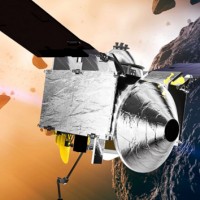
 NASA’s Goddard Space Flight Center/Conceptual Image Lab(NEW YORK) — In a little over a month, scientists could be one step closer to understanding fundamental questions about the origins of our planet and the human race — and they will be learning from an asteroid that could threaten to destroy us.
NASA’s Goddard Space Flight Center/Conceptual Image Lab(NEW YORK) — In a little over a month, scientists could be one step closer to understanding fundamental questions about the origins of our planet and the human race — and they will be learning from an asteroid that could threaten to destroy us.
The OSIRIS-REx Mission, headed by NASA and the University of Arizona, plan to launch an unmanned spacecraft on September 8 in the efforts to reach Bennu, a large near-Earth asteroid in August 2018, according to a website devoted to the mission.
The spacecraft will survey Bennu until a small vacuum-like device is capable of hovering above the asteroid and sucking up somewhere between 60 and and 400 grams of “gravel and soil” to bring back to Earth in the year 2023, according to Dante Lauretta, a professor of planetary science and cosmochemistry at the University of Arizona’s Lunar and Planetary Laboratory, and the principal investigator on the OSIRIS-REx mission, who spoke to ABC News by phone from Cape Canaveral, Florida, where he is preparing for the final stages of the mission.
“We believe Bennu is a time capsule from the very beginnings of our solar system,” Lauretta said. “So the sample can potentially hold answers to the most fundamental questions human beings ask, like ‘Where do we come from?'”
As well as helping us understand how life on Earth began, the soil sample will also bring us closer to determining whether life occurred on Mars or Europa, a moon of Jupiter that scientists believe may be habitable due to the likelihood of lakes of liquid water lying beneath its frozen crust.
Lauretta said that as a near-Earth asteroid, Bennu once existed in what he described as a main asteroid belt, located between Mars and Jupiter. There, it was likely dislodged by a gravitational pull towards Saturn, sending it closer to us.
He said that the asteroid could indeed strike Earth, and cause tremendous destruction, but that we shouldn’t be too frightened by it.
“Don’t run out and buy asteroid insurance,” he joked.
Bennu has a one in 2,700 chance of hitting Earth, and such an event wouldn’t take place for 150 years, he said. People living in the year 2135 would know whether the asteroid posed a threat to hit Earth, he said. In such an instance, Bennu would enter what Lauretta described as a “keyhole” located between the Earth and the moon that would send it in the direction of Earth.
A one in 2,700 chance isn’t too insignificant, however. Your chance of being killed by “firearms discharge” is roughly one in 7,944, according to the National Safety Council.
Lauretta said that by the time that it would strike, we would likely have the technology to destroy Bennu, although he acknowledged that we don’t have that capacity right now. He mentioned “nukes” as a potential means to protect Earth from Bennu, as well as what he described as a “gravity tractor,” or a space craft that would disrupt Bennu’s gravitational pull and send it careening off course from Earth.
“I wish I could be around in 2135 to see what happens,” Lauretta said.
Lauretta, who started the OSIRIS-REx Mission in research form in 2004, said he’s feeling “anxious and proud” in the days preceding its takeoff. His team, which had as many as 450 full time employees, is now scaling down as the launch approaches.
“It’s a tense moment for all of us,” he said.
In addition to preparing for the mission, Lauretta is trying to get a younger generation interested in his subject. “Xtronaut,” a board game he created to teach children about space exploration, retails on Amazon for $35.
Copyright © 2016, ABC Radio. All rights reserved.















